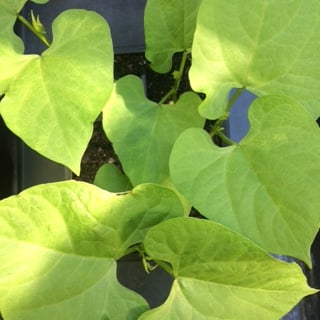
The greenhouse’s most bonny specimens at the moment are beans, almost bursting out of their pots and modules desperate to get out into the ground. And it won’t be long. I have a few types on the go. Most shamefully I have broad beans, which is an admission that all of those I sowed in autumn and over winter failed one way or the other – those I sowed direct didn’t come up, and those I sowed in the garden got a little neglected and didn’t look healthy enough to face the outdoors at planting out time – so now I am left shockingly broad beanless in May.
I sowed them about a month ago and they will be so late that they will turn up with the courgettes rather than the artichokes, but I couldn’t quite resist giving them a late go. There are also far more seasonally appropriate beans coming along too, including borlotti ‘Lingua de Fuoco’ and French bean ‘Blue Lake’, two of my favourite crops, grown the same way for completely different results. Both beans are tender, and so have needed to be in the greenhouse right up until now, just in case of frosts. In Bristol in early May we can be reasonably confident now that frosts have passed, though that is not the case throughout the whole of the country. And even here it is still pretty cold. I am being wary, but starting now to think about moving them out and hardening them off for planting out.
The planting out of the beans is one of the big jobs of the allotment year, on a par with potato planting in that I often seem to need to take the seedlings up to the plot for several visits before I manage to actually get them into the ground, manured, supported and protected from the elements and the pests. The best thing to do is to recognise this and do all the prep ahead of time. I am aiming to have all of their paraphernalia in place before they get there, and to only take the seedlings themselves up to the plot when I am absolutely sure I can just pop them into the ground. Beans are a hungry crop, and so I have been making ‘bean trenches’ ahead of planting out. This is something that you could have been doing all through winter: mine are a very minimal version of the whole shebang, which if you want to do it properly involves digging a trench in autumn, filling the base with wet newspaper, and then dropping in your compostable waste all through the winter, covering it with compost as you go, so that by this moment in the year you have a deep, mushy and highly fertile substrate to plant those thirsty and greedy beans in to.
I did not do this, but mine are not too bad an imitation: recently dug trenches filled with lots of garden compost. Im hoping they will give the beans a good moist root run and fuel lots of cropping anyway. Cropping is the time that these two types of beans separate themselves from each other, of course. The French beans want to be picked little and often as soon as they start producing, while still as young and tender as possible, though I am told that ‘Blue Lake’ is one of the best for avoiding stringiness and staying tender longer. The more you pick the more they will produce. The borlottis must be left, until the leaves turn butter yellow in autumn and the beans begin to dry. With luck and no late frosts I will have fresh French beans all summer and dried borlotti beans all winter, all from a May planting out.


